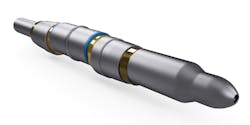Fast-track offshore trial proves new cost-reducing P&A technology
A new well abandonment tool developed by Aberdeen-headquartered Deep Casing Tools has gone from concept to offshore trial with Equinor in just nine months.
Deep Casing Tools’ first prototype Casing Cement Breaker was trialed in a well on Equinor’s Huldra field in the Norwegian North Sea, as part of a plugging and abandonment program (P&A), just weeks after the Norwegian operator’s staff were introduced to the tool by drilling services company Archer.
Deep Casing Tools says that the Casing Cement Breaker deals with problem cement in casing, which hinders conventional methods for P&A and slot recovery, when operators want to extend production. By breaking the bond between the cement and breaking down the structure of the cement behind the casing, well abandonment methods including perforate and wash, cut and pull and milling are simplified and easier or, in the case of milling, are no longer needed, saving operators significant time and cost and reducing risk and uncertainty.
The hydromechanical tool, which is run downhole on drill pipe, works using pressure and rotation to manipulate the existing casing in the well, within its elastic limits, breaking down the bond between cement and casing, as well as the structure of the cement behind the casing.
The successful trial of the prototype, which is now being developed into a stronger, second-generation tool, look set to be transformational for Deep Casing Tools, by opening the casing and completion technology business to a new market in well abandonment.
Well abandonment is estimated to account for 45% of the entire cost of decommissioning. In the next decade, some 1,400 wells are due to be abandoned on the UK continental shelf alone. With higher oil prices, operators increasingly want to re-use well slots, to drill new wells, a task the Casing Cement Breaker is designed to make easier.
David Stephenson, Deep Casing Tools’ CEO, said: “This was an idea on a white board just nine months ago. We have now proven it works with our very first prototype. We’ve proven it breaks down the bond between the cement and the casing, as well as the structure of the cement behind the casing, and that it reduces the forces needed to remove casing – by around 50% on this first trial. We expect to achieve 90% reduction as seen on testing with future generations of the tool. For operators, this means less time and cost. You can pull longer sections with less force, fewer trips, fewer cuts, and less rig time.”
Following the trial, Deep Casing Tools said that it already has two more offshore trials lined up with another major oil company, for later this year and early 2020. In anticipation of increasing interest in its Casing Cement Breaker, Deep Casing Tools is working with manufacturers to help bring future tools to market faster. •



